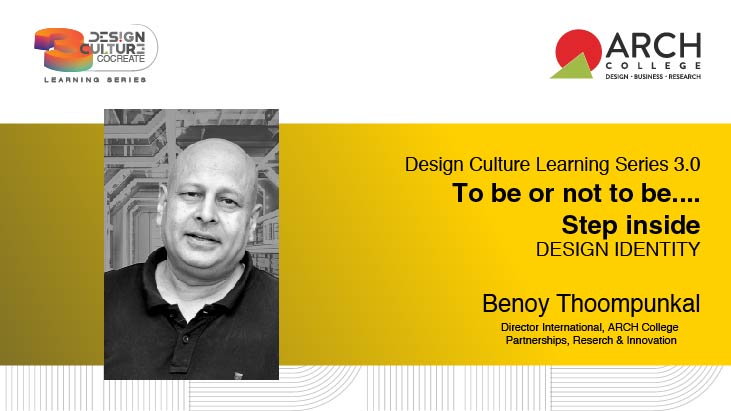Introduction:
Design Culture Learning Series, where creativity and innovation are celebrated. In this exciting series, Mr. Benoy Thoomkpunkal, Director International, Arch College of Design & Business, emphasizes the importance of embracing new experiences, taking risks, and venturing into uncharted territories. He also explained how to challenge your limits, ignite your creativity, and find the courage to answer the question that lies at the core of our existence – “To be or not to be.”
The Temptation of Shortcuts:
Step inside the world of shortcuts, where the possibilities are endless and the outcomes are unpredictable. As the saying goes, “Shortcut is not always short, sometimes it’s a long cut.” This rings true in various aspects of life, whether it be solving riddles or even making decisions within a committee.
When it comes to solving riddles, shortcuts may seem like the obvious choice for finding the answer quickly. However, these shortcuts are not always the most efficient. As demonstrated by a collection of short riddles, some are easy and straightforward, while others require more thought and creativity. Even within committees, shortcuts can be taken to avoid making decisions. Samuelson’s Reflection highlights that the real objective of a committee is not to reach a decision but to avoid it altogether. This approach may seem like a shortcut to avoid conflict or difficult choices. However, in the long run, it can lead to stagnation and a lack of progress. Sometimes, taking the longer route of discussing and reaching a decision is necessary for growth and development.

Original Thinking: “The Attic of the Brain” by Lewis Thomas
Original thinkers, whether they are artists, inventors, writers, or entrepreneurs, possess certain habits that set them apart. They understand that great ideas are made, not born, and are not afraid to have bad ideas along the way. Procrastination can actually lead to increased creativity for original thinkers as they thrive under the pressure of a time crunch. They are not afraid to question conventional wisdom or go against the grain to have original thoughts. While they are influenced by others, they use that influence to create something new and exciting rather than simply following trends. These habits can be practiced by anyone who wants to become an original thinker and unlock their own creative potential.
In the essay “The Attic of the Brain,” Lewis Thomas argues for preserving the mystery of the human mind and not overanalyzing our choices. He believes that overthinking and cluttering our brains with excessive information can lead to internal conflicts and feelings of guilt. Instead, Thomas suggests allowing our minds to be free and embracing the flood of ideas that naturally occur in our brains. He points out that the unconscious mind is responsible for creativity and discovery, and trying to control our thoughts too much can hinder that process. By following Thomas’s advice and allowing our minds to be open and free, we can tap into our own original thinking and unlock our creative potential.

Applying Design Thinking Across Industries:
Design thinking is not just about creating new things, but it is also about improving and making things more usable. It is a problem-solving approach that businesses can use to enhance their products, services, and customer experience. By looking at problems from a user’s perspective, design thinking allows for creativity and collaboration to come up with innovative solutions. This approach can be applied in various ways, such as improving product design, developing new services, creating better customer experiences, and devising effective marketing strategies. The design thinking process involves understanding the problem, generating ideas, selecting the best solution, prototyping, testing with customers and stakeholders, and refining based on feedback. With its emphasis on empathy and experimentation, design thinking has the power to generate unique and creative solutions that can drive business growth and innovation.
Power of AI in Design:
Design is a complex and ever-evolving process, and with the introduction of artificial intelligence (AI), it has become even more exciting. AI has the potential to revolutionize the way designers create and optimize their designs. Instead of being seen as a threat, AI should be viewed as augmented intelligence that can enhance and speed up the design process. By analyzing data and suggesting design adjustments, AI can help designers create and test prototypes more quickly, saving time and resources. Moreover, AI can automate repetitive tasks like localization and graphics creation, freeing up designers to focus on more creative aspects of their work. The possibilities are endless as AI algorithms have already generated millions of unique packaging designs for brands like Nutella. In the world of virtual reality (VR), augmented reality (AR), and mixed reality (MR), AI can assist designers in building 3D worlds more efficiently. Ultimately, designers will collaborate with AI to leverage its opportunities and make designs smarter, opening up a whole new realm of possibilities in the field of design.

Conclusion:
To Be or Not to Be is a common question that has been asked in every culture throughout history. What makes life worth living? Is there a difference between being alive and being dead? What is the purpose of life? And most importantly, can we change our lives? These are all questions that people have asked themselves throughout the years. Nowadays, the answer to these questions is becoming increasingly difficult to find. This is due to the fact that we live in a world that has been intricately designed by people and companies to keep us distracted and engrossed with distractions. From online shopping to social media addiction to gaming, there is rarely enough time to find our own direction and meaning in life.
And, Great design is not about following a set of rules, rather it’s about challenging existing conventions and coming up with something new and exciting. You can’t always create the best work by simply playing it safe, and that’s where the magic lies. Great design comes from taking risks and stepping out of your comfort zone. This is why the best designers are not afraid of making mistakes. They are willing to take calculated risks that can potentially lead to better results. However, it is important to remember that with great risks come great rewards. If you want to be successful, you must take the right risks.
